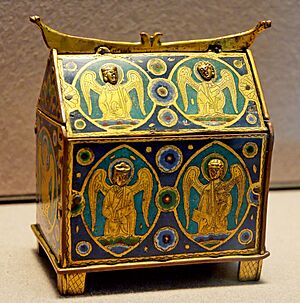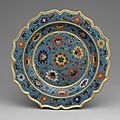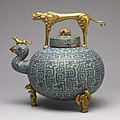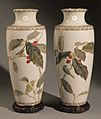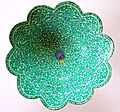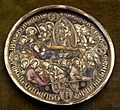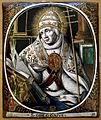Enamel (glass) facts for kids

Enamel is a special material made from melted glass. It is often used to cover metal objects. You might also hear it called vitreous enamel or porcelain enamel.
To make enamel, powdered glass is heated until it melts and sticks to a base, usually metal. This heating process, called firing, happens at very high temperatures, usually between 750 and 850°C (1,380 and 1,560°F). When the powder melts, it flows smoothly and then hardens into a strong, shiny coating. This coating can be put on metal, glass, or ceramic items.
Enamel has been used for thousands of years to decorate objects. It was especially popular in Europe during the Middle Ages. In the 1800s, people started using it for everyday items like kitchen pots and pans, and even road signs. Enamel is great because it is tough, hard to scratch, and very easy to clean.
Contents
What is Enamel?
Enamel is basically glass that has been melted onto another surface. Think of it like a very strong, colorful glaze. It creates a smooth, hard layer that protects the object underneath. This layer can be very shiny and colorful, making objects look beautiful.
The word "vitreous" means "glassy," which helps you remember that enamel is made from glass. "Porcelain" is another word often used because the finished surface can look similar to porcelain.
How is Enamel Made?
Making enamel involves a few key steps. First, glass is ground into a very fine powder. This powder is then mixed with water to create a paste. This paste is applied to the surface of an object, often made of metal like copper, silver, or gold.
After the paste is applied, the object is placed in a very hot oven, called a kiln. The high heat melts the glass powder. As it cools, the melted glass hardens into a smooth, durable coating. This process is called firing. Sometimes, several layers of enamel are applied and fired to create different colors or effects.
A Look at Enamel's History
People have been using enamel for a very long time, for about two or three thousand years! Ancient Egyptians and Romans used it to decorate jewelry and other precious items.
During the Middle Ages in Europe, enamel became very popular. Artists used it to create beautiful religious objects, jewelry, and decorations for churches. Famous types of medieval enamel include champlevé and cloisonné.
- Champlevé enamel involves carving grooves into the metal surface. The enamel powder is then placed into these grooves before firing.
- Cloisonné enamel uses thin metal wires or strips to create small compartments on the surface. These compartments are then filled with different colors of enamel.
In the 1800s, enamel started to be used for more practical things. It was put on cast iron bathtubs, kitchen sinks, and even cooking pots. This made these items easier to clean and more resistant to rust. Today, enamel is still used for many things, from jewelry to industrial equipment.
Why is Enamel Useful?
Enamel has many great qualities that make it useful:
- Durability: It's very strong and can last a long time without fading or chipping.
- Scratch Resistance: The hard glass surface makes it difficult to scratch.
- Easy to Clean: Its smooth, non-porous surface means dirt and grime don't stick easily, making it simple to wipe clean.
- Chemical Resistance: Enamel can resist many chemicals, which is why it's used in some industrial settings.
- Beauty: It can be made in many vibrant colors and finishes, adding a decorative touch to objects.
These qualities make enamel a popular choice for everything from delicate art pieces to tough industrial coatings.
Images for kids
-
A Gothic châsse (a type of casket) from 1185–1200. It uses champlevé enamel over gilded copper and is at the Louvre-Lens museum.
-
A Chinese dish with a scalloped rim from the Ming Dynasty (early 1400s). It uses cloisonné enamel and is at the Metropolitan Museum of Art.
-
The Staffordshire Moorlands Pan, a 2nd-century Roman object found in Roman Britain.
-
A Chinese cloisonné enamel bronze wine pot from the 1700s.
-
Imperial vases by Ando Jubei, decorated with the chrysanthemum crests of the Imperial family. The design is slightly raised using a technique called moriage. From the Khalili Collection of Japanese Art.
-
A beaker made of silver, silver gilt, and painted enamel from the Burgundian Netherlands, made around 1425–1450. It is at The Cloisters in New York City.
-
A grisaille painted Stations of the Cross artwork, possibly from Limoges, at Notre-Dame-des-Champs in Avranches.
-
St. Gregory the Great in painted Limoges enamel on a copper plaque, made by Jacques I Laudin.
See also
 In Spanish: Esmalte para niños
In Spanish: Esmalte para niños


